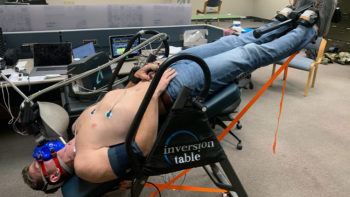NASA Funds Texas A&M Research On Effects Of Altered Gravity

NASA’s Human Research Program is funding two Texas A&M University proposals led by Ana Diaz Artiles, assistant professor in the Department of Aerospace Engineering, to study the effects of altered gravity on bimanual coordination and cardiovascular and ocular health.
“We cannot recreate microgravity, per se, but we can manipulate the gravity vector and learn from that,” Diaz Artiles said. “We have proposed to run a set of experiments using devices here on Earth to understand gravitational effects on human performance, and then extrapolate what would happen in space and on other planetary surfaces.”
Humans are pulled toward the Earth’s surface at approximately 9.8 meters per second squared, otherwise known as acceleration due to gravity. This is measured as 1G (g-force). In space, there is microgravity, or 0G. As astronauts leave Earth and enter space, they could be exposed to altered gravity somewhere between 0G and 1G. Many astronauts have experienced this phenomenon, but little is known about how the body reacts to different gravitational environments.
Diaz Artiles’ first proposal looks at uncovering the effects of altered gravity on bimanual coordination. Subjects will participate in a parabolic flight — a flight that maneuvers in the shape of a parabola, creating gravitational changes ranging from 0G to 1.8G. The subjects will be asked to complete a series of tasks during the parabolic flight that require bimanual coordination — the ability to move both upper limbs to manipulate objects or perform tasks. An example of bimanual coordination is force coordination (pushing down on force sensors in a specific pattern) or movement coordination (moving both arms in a specific pattern). The tasks will be completed at 0G, .25G, .5G,.75G, 1G and 1.8G to demonstrate the differences in performance at different gravity conditions.
“In a parabolic flight, there is true partial gravity,” Diaz Artiles said. “The beauty of this flight is that, depending on the parameters of this parabola, you can create any partial gravity level that you want. With a parabolic flight, we will investigate how the gravity level affects a human’s ability to perform bimanual coordination tasks at different levels in between 0G and 1G.”
Co-investigator Deanna Kennedy from the health and kinesiology department at Texas A&M specializes in bimanual coordination, and will aid in these experiments.
Another critical aspect of parabolic flight research is motion sickness. In a spaceflight, many astronauts are given medication like promethazine to counteract nausea or vomiting. However, this medicine is known to have adverse side effects such as drowsiness and a reduction in the ability to perceive tilt motions. Little is known about the effects of anti-motion sickness drugs on sensorimotor functions. Part of the study will investigate how promethazine affects bimanual coordination, since this skill is often critical in tasks like driving a rover and piloting a spacecraft.
The second proposal will look at the health of subjects who experience altered gravity, specifically concerning ocular and cardiovascular changes that have been associated with spaceflight.

The first way the researchers will investigate the effects of altered gravity is with a standard tilt table. By tilting subjects at different angles, they will experience multiple gravity vectors in the head-to-toe direction, causing pronounced fluid shifts, similar to what astronauts experience during spaceflight. Researchers believe that altered gravity can cause changes in vision, as well as changes to the cardiovascular system, such as changes in fluid distribution. The researchers will use the tilt table to look at how the blood distributes throughout the body while experiencing altered gravity and how this affects these ocular and cardiovascular functions.
Second, the researchers will use a lower body negative pressure (LBNP) device. The device generates negative pressure that moves fluid from the upper body to the lower body.
“Once you put the LBNP on, you are subjected to negative pressure pulling the blood down, back to your legs,” Diaz Artiles said. “It is a way to create orthostatic stress, similar to a gravitational stress. We can also generate positive pressure, and the opposite effect happens like you’re standing upside down. We want to generate gravitational dose-response curves and study the difference between altered gravity responses and normal responses at 1G.”
The last method in the study will use a human-rated short radius centrifuge, which is being installed at the Texas A&M campus. Co-investigator Bonnie J. Dunbar, professor in the aerospace engineering department and former astronaut, will facilitate the move of this centrifuge from the University of Texas Medical Branch in collaboration with NASA.
The centrifuge spins subjects around, simulating gravity effects. Commonly used in astronaut training, the researchers will use this machine to study the health impacts of gravity and create gravitational response curves.
Both projects are in their beginning stages. While different in method, they look to solve complex problems associated with human health and performance during spaceflight.
“A general theme of my research is understanding gravitational impacts on human performance, and this includes multiple physiological systems such as muscular, cardiovascular or sensorimotor,” Diaz Artiles said. “I am very excited to conduct this research and gain a better understanding on how gravity affects human performance.”
This article by Michelle Revels originally appeared on the College of Engineering website.





